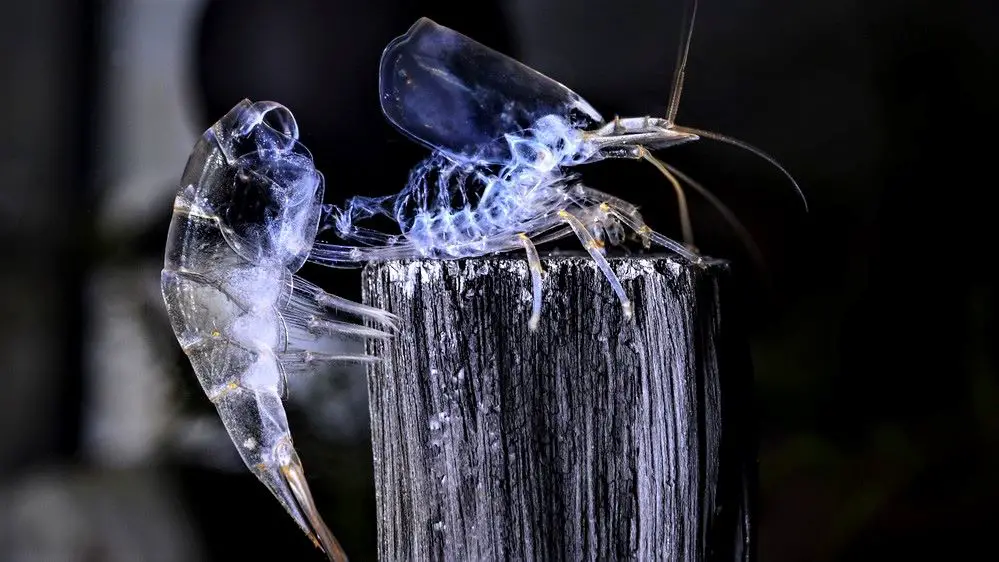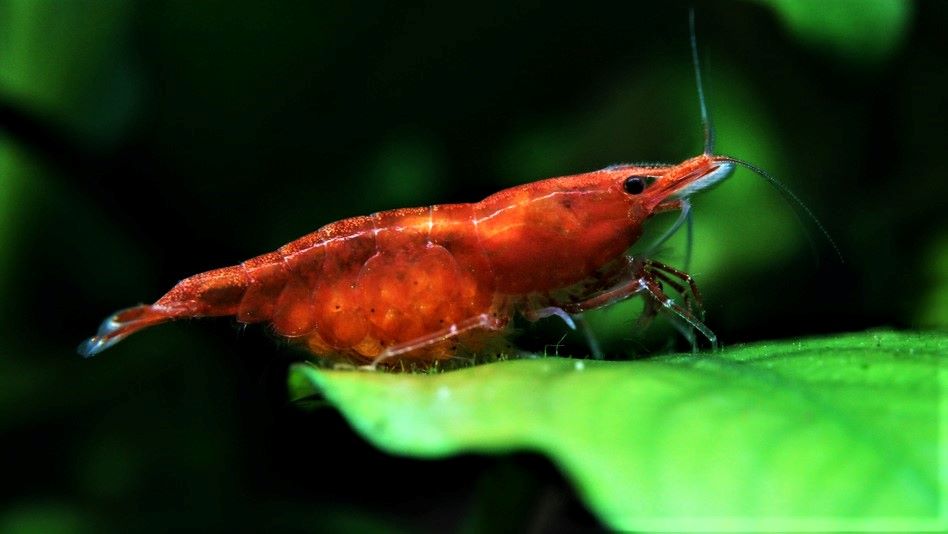Witnessing your shrimp zoom around as though participating in a sprint can be both delightful and puzzling. Especially noticeable after a water change or a female shrimp’s molt, what could possibly spark such a surge of energy in these typically placid beings? Let’s dive into this intriguing shrimp behavior.
or a female shrimp’s molt, what could possibly spark such a surge of energy in these typically placid beings? Let’s dive into this intriguing shrimp behavior.
Shrimp often swim around the tank fast as a reaction to changes in their environment, such as a water change, or in response to a female shrimp molting, which can trigger a male breeding response.
I’ve had my fair share of puzzling moments as a seasoned shrimp keeper. One of the most intriguing behaviors I’ve observed is my red cherry shrimp’s sudden flurry of activity. One minute they’re peacefully grazing on algae, and the next, they’re zooming around the tank like tiny aquatic sprinters.
This behavior often coincides with a water change or when a female shrimp has molted. It’s a fascinating spectacle, but it also raises questions. Is this normal? Are my shrimp stressed? Or is this a sign of something more exciting, like a breeding ritual? Over the years, I’ve learned that it can be a bit of both.
Understanding these behaviors and knowing how to respond can make all the difference in maintaining a healthy, thriving shrimp tank. So, let’s explore why our little aquatic friends might suddenly decide to turn your tank into their personal racetrack.
What Triggers Fast Swimming in Shrimp?
In the tranquil world of your aquarium, the sudden burst of speed from your shrimp can be quite a spectacle. This fast swimming, often called “zoomies” by shrimp enthusiasts, can be triggered by several factors.
One of the most common triggers is a change in their environment, such as a water change. Shrimp are sensitive creatures, and any alteration in their habitat can cause them to react. The change in water temperature, pH, or even the introduction of new water can stimulate this swift swimming response as they explore and adjust to their refreshed surroundings.
Another significant trigger is the molting process in female shrimp. Molting is a natural occurrence where shrimp shed their old exoskeleton to grow. When a female shrimp molts, it’s often a signal that she is ready for breeding. This event can send male shrimp into a frenzy, darting around the tank for the freshly molted female. It’s their version of a romantic chase, a courtship dance in the aquatic world.
It’s important to note that while these behaviors are normal, excessively frantic swimming could be a sign of stress or discomfort. This could be due to poor water conditions, sudden temperature changes, or toxins.
As a shrimp keeper, it’s crucial to keep a close eye on these behaviors, as they are your shrimp’s way of communicating their comfort level in their home.

How Does a Water Change Affect Shrimp Behavior?
Water changes are an essential part of maintaining a healthy aquarium environment. However, this routine maintenance can be quite an event for our tiny shrimp friends. Shrimp are sensitive to environmental changes, and a water change, even when done correctly, can cause a noticeable shift in their behavior.
Introducing new water into the tank often comes with slight variations in temperature, pH, and mineral content compared to the existing water. Shrimp, being the sensitive creatures they are, can detect these changes. As a response, they might start swimming around more actively, exploring their refreshed surroundings. This is their way of acclimating to the new conditions.
Another interesting behavior occurs when a water change coincides with a female shrimp’s molting cycle. The water change can trigger the female to molt, signaling to the males that she is ready for breeding. This can lead to a flurry of activity in the tank as the males enthusiastically search for the molted female.

What Role Does Molting Play in Shrimp Activity?
Molting is a natural process in the life of a shrimp, a necessary event that allows them to grow. However, it’s not just about growth; molting plays a significant role in shaping shrimp activity and behavior, particularly concerning breeding.
When a female shrimp is ready to molt, she releases pheromones into the water. These pheromones signal to the male shrimp that she is about to molt and will soon be ready for breeding. This triggers a flurry of activity in the tank, with male shrimp darting around in an excited search for the female. It’s a bit like a romantic chase scene unfolding right in your aquarium.
Molting is a vulnerable time for shrimp, as they shed their old exoskeleton before the new one hardened. During this period, the shrimp often hide and remain relatively inactive to avoid potential predators. Once the new exoskeleton hardens, the shrimp resumes its normal activity.
So, while molting might seem like a simple process of shedding and growing a new shell, it’s actually a key event that significantly influences shrimp behavior. It’s a time of vulnerability, a trigger for breeding activity, and a fascinating display of nature’s cycle of growth and renewal.

How Can I Ensure My Shrimp Are Comfortable and Not Stressed in Their Tank?
Creating a comfortable and stress-free environment for your shrimp involves a combination of maintaining optimal water conditions, providing suitable habitats, and observing their behavior for any signs of discomfort.
Firstly, keeping the water parameters within the ideal range for your specific type of shrimp is crucial. This includes factors like temperature, pH, hardness, and nitrate levels. Regular testing can help you monitor these conditions and make necessary adjustments. Remember, sudden changes can stress your shrimp, so any adjustments should be made gradually.
Secondly, the physical environment of your tank plays a big role in your shrimp’s comfort. Shrimp love to have plenty of hiding spots where they can retreat and feel safe, especially during molting. Providing a variety of plants, rocks, and other decor can create a more natural and comforting habitat for them.
Feeding your shrimp a balanced diet is also essential. Ensure they’re getting a mix of commercial shrimp food and natural food sources like algae and biofilm. Overfeeding can lead to poor water quality, so it’s better to feed little and often.
Lastly, keep a close eye on your shrimp’s behavior. Increased activity during a water change or after a female shrimp molts is normal. However, if you notice your shrimp are constantly darting around the tank, hiding more than usual, or not eating, these could be signs of stress.
In such cases, it’s essential to check your water parameters and observe if there are any potential stressors in the tank, like aggressive tank mates or poor water quality.
Maintaining a stable, well-structured environment and being attentive to your shrimp’s behavior can ensure they lead a comfortable and stress-free life in your aquarium.
In Summary: The Intricacies of Shrimp Behavior in Your Aquarium
Understanding the behaviors of your shrimp and the triggers behind them is a fascinating part of shrimp keeping. From the fast swimming induced by water changes or a female’s molt, to the importance of molting in their life cycle, and the ways to ensure a stress-free environment, every aspect contributes to a thriving shrimp community in your tank.
Remember, your shrimp are sensitive creatures, and their behaviors often respond to changes in their environment. Keeping a close eye on their activities and maintaining optimal conditions in your tank can go a long way in ensuring their health and happiness.
If you ever find yourself puzzled by your shrimp’s antics or need help with any aspect of shrimp keeping, don’t hesitate to reach out. If you can’t reach me here, check out the various shrimp-keeping groups on Facebook. They’re a treasure trove of information and advice from fellow shrimp enthusiasts.
Finally, remember that shrimp keeping is not just about maintaining a tank, but about creating a home for these fascinating creatures. So here’s to creating the best homes for our shrimp friends.
Happy Shrimp Keeping!
FAQ: Understanding Shrimp Behavior in Your Aquarium
Q. What is the behavior of shrimp in a fish tank?
A. Shrimp in a fish tank are typically active and inquisitive creatures. They spend their time grazing on algae, biofilm, and other food sources. They also exhibit interesting behaviors such as fast swimming in response to environmental changes or a female shrimp’s molting process.
Q. What is a healthy shrimp behavior?
A. Healthy shrimp are active, always looking for food, and are often involved in breeding activities. They move around the tank with purpose, and their movements are not frantic or erratic.
Q. How do I know if my shrimps are happy?
A. Happy shrimp are active and inquisitive. They are always looking for food and are prolific breeders. Observing your shrimp’s behavior can give you a good indication of their happiness. If they are active and eating well, it’s a good sign they are content.
Q. How do you tell if a shrimp is stressed?
A. Signs of stress in shrimp can include constant frantic swimming, hiding more than usual, or not eating. These behaviors could indicate that the water conditions are not suitable or there are other stressors in the tank.
Q. How does a water change affect shrimp behavior?
A. A water change, even when done correctly, can cause a noticeable shift in shrimp behavior. They might start swimming around more actively as they acclimate to the new conditions. A water change can also act as a trigger for a female shrimp to molt, leading to increased activity in the tank.
